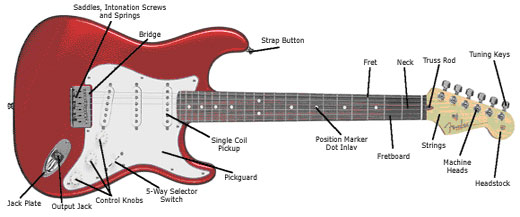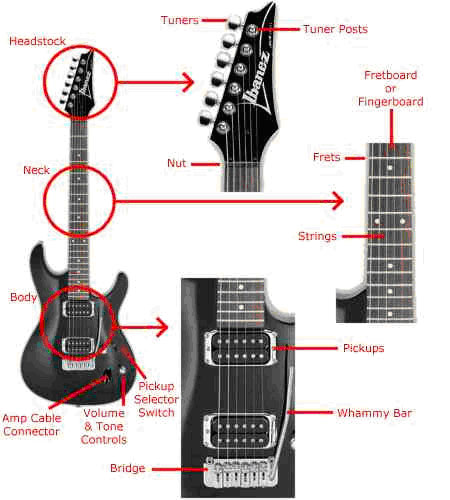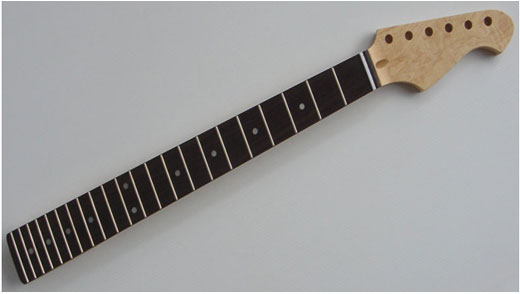Electric Guitar Buying Guide
KNOW YOUR ELECTRIC GUITAR
An electric guitar functions basically by converting the vibrations of the guitar strings to electric signals by using the principle of electromagnetic induction. An audio amplifier is made use initially as the electric signals generated are usually too weak. The early era of the twentieth century was literally boomeranged with the intro of electric guitars and no other musical instruments made the kind of impact like that of an electric guitar in Western Music. The electric signals of the guitar are altered to distortion or reverb with effects pedals. Broadly, electric guitars are favored for musical genres like Rock and Roll, Blues, Metal and Jazz too. The volume and depth are flavoured with the right effects and has proved time and again with an output of multitudinal sounds and styles.
BRIEF HISTORY OF AN ELECTRIC GUITAR
Though guitars have been in existence for more than 4000 thousand years now, electric guitars have their history only to a meager 80 years or so. The first electric guitar was made by Adolph Rickenbacker in the 1930s and the original ones used pickups made of tungsten. The vibrations of the strings are converted to electrical current and fed to the amplifier which in turns gives an output of the original sound.
The electric guitars gained popularity along with the Big Band era of the 1930s and the 40s. With the option and special feature to be plugged into an amplifier, the electric guitar rose above the loudness and brass sections of a jazz performance. Even though the electric guitar have not been in use as long enough like the classical or the acoustic guitars, there has been a reasonable and creditable development in style, structure and performance all through the years. The solid body electric guitar that is more in vogue today was created by Les Paul in the year 1941 who was both a musician and an inventor. These original Les Paul guitars were made without any sound holes and so they were plain and appeared to be a rectangular block which was attached to the neck with as many as six steel strings. The solid block now had been refined to a more round shaped Les Paul guitars of today. Gibson brought Les Paul’s creation to the world in 1950s and it has still remained as Gibson Les Paul with increasing popularity for more than a solid 50 years to follow.
During the same period as that of Les Paul, there was yet another inventor Leo Fender who designed his own version of solid body guitar. He introduced his Fender Broadcaster electric guitar and the Broadcaster was changed to Stratocaster officially in 1954. The Stratocaster was significantly different in shape, hardware and weight to that of a Les Paul. The Fender equals to that of a Les Paul in terms of popularity.
Over the years there were other popular companies like the Ibanez, ESP, Yamaha, Paul Reed Smith and the Jackson which all specialized in solid body electric guitars but they could not really over throw the similarity based on either a Les Paul or a Stratocaster.
FEATURES OF AN ELECTRIC GUITAR
An electric guitar broadly comprises of the body, neck and pickup.
Body types of an Electric Guitar
Three different body types claims to form the integral part of an electric guitar. The types of hardwood used are mainly maple, rosewood, mahogany, alder, ash and spruce. The tone of the wood selected tends to give a difference in its sound and resonance depending on the place where it is used and the design and maker.
Solid body guitars used either single or several pieces which are glued or topped together. They are highly popular for their sound with the amplification and the use of effects pedals on them. Fender Telecaster, Fender Stratocaster and the Gibson Les Paul are the three popular guitars which hold a solid body on them.
Jazz guitars are otherwise hollow body guitars which have a thickness of 2 inches and are quite hollow inside. They resemble an acoustic guitar in sound and have an echoing effect at a higher amplification.
The semi hollow body of an electric guitar has a thick slab of a wooden board running in between. It often is accompanied with two humbucker pickups which gives a good acoustic sound effect and yet good volume and depth with higher amplification.
Neck of an electric guitar
The neck forms an integral part of the electric guitar. As it could be said that no two guitarists play alike; the same goes with the fact that there are significant variations in the guitar necks too. The important factors that determine the neck is the type of wood, the joint and the profile of the neck.
The neck wood used for the neck piece of an electric guitar may be one single, solid wood or pieces which are tightly wound or laminated to make it ber. Weight of the wood plays a crucial part to the balance of the guitar as well as the hardness and the wood grains found in it. Maple wood is medium in weight as well as hardness and attempts at perfect balance without the neck being too heavy. Mahogany is more flexible and lighter than maple and is heavily favored for the acoustic guitars. Rosewood comes in many variations and forms a tight grained, heavy wood. It possesses a smooth quality and a hard surface and so makes a fine neck in an electric guitar. The Brazilian rosewood has now become extremely rare and quite expensive due to heavy usage and high rate of deforestation. The Pau Ferro has now become a replacement for this type of rosewood. But there is a slight risk of allergy to a nominal percentage of the users.
Neck Joint
The point where the guitar body is connected to the neck forms the neck joint and the process of joining is very important and crucial. It should be seriously noted that the joint should be able to tackle the pressure and withstand the stress and tension of the installed strings which can become very high. Also fixing the joint can lead in affecting the final tone of the guitar.
Set neck
As the name indicates, it simply means the process of gluing the neck in place. The mounting point and the set neck is seriously calculated giving more surface to glue and less wiggling with their dove-tail joints. Gibson Les Paul electric guitars are fine models for a set neck guitar.
Bolt on Neck
Leo Fender’s initial guitar set a lead model for this type of neck joint though he obviously did not use bolts. He used a set of four wooden screws even though some other manufacturers actually used bolts where the head of the bolt is deep set into the guitar’s body. These types of joints are found in maxims among solid body electric guitars.
Neck Through Body
The special neck joint is forged exclusively to solid bodied guitars. The neck runs along the entire body of the guitar and they are usually dove tailed joints. When the neck cuts into the entire length of the body, the mass of the body is further reduced and high noted bright sound is produced.
Profile of an Electric Guitar
The shape of the neck otherwise prominently known as the neck profile is an important feature of a guitar. The position of the hand and fingers differs for every guitarist and the C shape is the highly used and more user friendly profile in an electric guitar. The oval shape profile is also more similar to the C shape. The U shaped profile falls more in to the rectangular shape and is best for long fingered players. A regular V shaped profiles comes with a perfect groove in the middle down and is much more comfortable whereas the inverted V has a thicker bass and a thinner treble variation. Apart from the neck profile, the width and depth also plays a great role in the performance of the guitar.
Pickups
Single coil pickups
As history goes, the early electric guitars used only a single coil pickup. Even though most of the guitars use two pickups wherein the closer one to the neck allows a thick sound and the one next to the bridge produces a thin treble, they may be a single coil pickup. The variation of the switches is between a 3 position and a 5 position. It allows the player to choose the pickup or blend them easily.
There may be only a single magnet or separate magnet for each string and yet if only a single coil of string may be used and this is branded as a single coil pickup. The sound produced is extremely clean, thin and very transparent and have an average of 2 �-inch length and � th of an inch width.
The single coil pickup comes with a drawback of electromagnetic radiation. It picks hum from all over the wiring, lighting and lately from computer monitors and hence single coil pickups are highly susceptible in terms of hum. These types of pickups are popular in the Fender Guitars.
Humbucker Pickups
In the early 1950s the Gibson set upon working on a pickup which would not be highly prone to the humming of all the electromagnetic radiation around. The usage of two coils to cancel or known to buck the surrounding hum was designed and popularly known as the humbucker. It used two coils or effectively two magnets. Both the coils are used to carry two different signals like the vibration and the noise signal which is cancelled effectively.
These days many of the guitars provide a combination of both the type of coils with a switch to control the choice.
FEATURES FOR RAIN CHECK WHEN BUYING AN ELECTRIC GUITAR
Scale length is the length of the string between the bridge and the nut. This length has a lot of influence in the quality of tone at a particular string at a certain pitch. Longer scales tend to have great distance between the frets too. There are 3 distinct scale length used commonly. The 24-5/8″ Gibson scale of the Les Paul guitars which are specified for their thick bass, the 25-1/2″ Fender scale which produces a clear, and cutting tone and also the 25″ Paul Reed Smith which has a definitely distinctive and more finite tone which stands nowhere between both the predecessors.
Nut width of a guitar refers to the width of the fingerboard or the neck. Depending on the size of the players fingers or his preference in positioning the fingers, a wider neck or a narrow neck can be chosen.
The curve of the fingerboard gives the measurement for the radius of the fingerboard. Modern electric have a larger radius of sixteen inches wherein the fingerboard is much wider. Older guitars with less than ten inches of radius tend to have a narrow fingerboard and also have their notes cutting off when string bends are played. Some guitars come with a compound radius which gives the best of both the modern and older versions of fingerboards.
Intonation in an electric guitar makes sure that when the notes are played above the 12 th fret is in tune. If the distance is totally off above the 12 th fret, an electric guitar will lose its tuning and renders useless in any performance.
Frets in an electric guitar is usually found to be 22 in number and one chooses to handle a 24 fret neck, it provides a totally complete and full octave when raised above the 12 th fret.
Bridge in any guitar and especially in an electric guitar is either a tremolo or a stoprail bridge. Each of them has a distinctive quality of its own. In a tremolo bridge, the player has the full freedom and flexibility to bend all the strings or dive into them at one single go which goes in accordance with a Metal genre and also it can throw out of tune very easily. On the other hand a stoprail has a stable tuning as it completely fixed to the body of the guitar and gives more sustenance.
Finally the tuning machine of the guitar helps in holding the pitching and tuning of the music. Built in or enclosed machine heads are free from rusting and corrosion and open tuning machine leads to more maintenance.
MAIN ACCESSORIES
Amplifiers
As well known, an amplifier helps to increase or amplify the guitar’s sound. Depending on the location, one can choose the type of amplifier and its speakers. It ranges from 15 watts to 50 watt models and 6 inch to 15 inch diameter speakers.
Amplifiers come with many controls. It is highly useful to have not only an on/off switch but also a volume control, separate control for high and low tones for bass and treble. Some amps come with a midrange control to adjust and have a perfect balance in between them. One output and input jack is essential along with a reverb echo control.
Different types of amplifiers are the solid state, tube and modeling amps. The solid state amplifiers make use of the transistors which are lighter than the tube and resulting in less cost and higher durability. The tube amplifiers which use vacuum tubes are heavier and costlier. They are highly fragile and easily wear off. Still the sound produces from them makes it preferable to the guitarist. Modeling amplifiers rely on the digital processors in simulating the sound and has preset tones and built in digital sound effects.
Effects Pedals
Many guitarists these days make use of the effects pedals which enhance their performance. There are effects pedals which come with a single or multiple effects. Some of the effects are the Chorus, Compressor, Delay, Distortion, EQ, Fuzz, Modelling, Octaver, Phaser, Reverb, Sampler, Talkbox, Tremolo, Vibrato, Volume etc.
ADDITIONAL HANDY ACCESSORIES
There are other accessories like the case which comes in two types. The hard shell and the soft shell casing are the two types. The hard shell is useful for professional and regular users where as the soft shell casing is for learners or occasional uses.
It is always better to have a few set of extra strings as they tend to snap easily. New strings sound quite better and feel good to have a string winder handy.
One can have picks ready as they tend to miss or get lost easily. Also an electronic tuner helps to easily tune before playing. Straps help you to support the weight of the guitar easily when performing while standing. It is an important accessory when purchasing a guitar. Proper cables should accompany an electric guitar get connected to an amplifier. Stand, slide and a Capo are additional accessories which usually accompany a guitar.
The instruction manual in the form of books, CDs or DVDs gives the user lot of help and should be valued a lot in learning about the guitar.
BUDGETING YOUR GUITAR
It is good to remember that when investing in the purchase of a guitar, it is wise to go for a higher quality one. The performance tends to be better and gives more motivation and inspiration. The richness of the music grows with aging and usage. The longevity or life of the guitar is good when a good quality instrument is opted. It also tends to have a good resale value to it.
WARRANTY AND SERVICE
As with all other purchases, looking out for a good warranty and maintenance service should be borne while buying a guitar.





